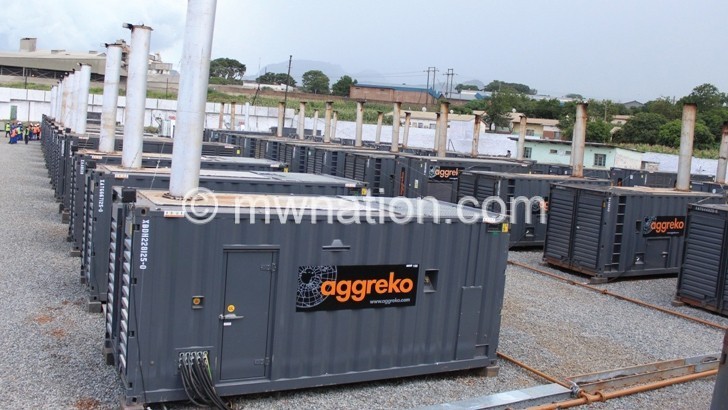Dark days For escom
Broke and broken after being stripped of its main revenue generating assets, debt-ridden Escom is headed for a crash that could plunge Malawi into darkness—literally.
Worsening the Electricity Supply Corporation of Malawi’s (Escom) woes is government’s latest decision to take away its single buyer function to form Power Market Limited (PML, thus choking off another major revenue stream for the parastatal that already lost its generation arm to a similar dismantling fashion.
The single buyer hive off joins a list of devastating blows that Escom is going through, including dwindling working capital and gross inefficiencies which have plunged it into liabilities that are becoming increasingly hard to sustain.
For example, by end March 2020, Escom owed Energy Generation Company (Egenco) K41 billion, National Oil Company of Malawi (Nocma) and Aggreko K2 billion each, according to documents and sources at Escom, Egenco and Malawi Energy Regulatory Authority (Mera).

Escom also owes billions to several firms that supplied equipment in deals most of which—according to a report by the National Audit Office (NAO) released in 2018—were either misprocured or had prices inflated.
Most of the goods bought, said the parastatal’s board chairperson Thom Mpinganjira two years ago, would not be needed for years and would likely be obsolete by then.
Those bad procurement decisions—said Mpinganjira at the time—saw the company stockpile K18 billion by February 2018.
Three months later [by May] that surplus cash evaporated into a K50 billion deficit dug more deeply by questionable procurement decisions. The company became so desperate that it asked Treasury for K58 billion in bailouts.
Treasury, which had just forked out a K45 billion rescue package to Admarc—another procurement scandal-ridden behemoth—refused to throw good money after bad in Escom’s bottomless pit.
Escom is now in a position where its current liabilities have been increasing higher than the current assets, thereby resulting in a liquidity squeeze for the company, according to a 2018 Annual Economic Report produced by the Ministry of Finance, Economic Planning and Development.
Escom’s working capital has also dipped sharply, plunging to K21.4 billion at the end of 2017 from K34.8 billion 12 months earlier, and was estimated to fall further to K16.4 billion by June 2018.
The Economic Report predicted that the working capital position would deteriorate further, but it is not clear what the situation is at the moment because the 2019 Annual Economic report did not provide details on Escom’s financial performance.
The parastatal is also heavily indebted to local commercial banks after obtaining loans to reduce the Egenco bill and finance its operations, according to a source at the parastatal.
But Escom’s unsustainable debts and fast deteriorating cash-flow levels mean that even if producers generate massive megawatts, it could end up too broke to fulfil its dispatcher responsibilities of taking power into homes and businesses.
And that—in an environment ravaged by Covid-19, uncertain political and policy direction as well as lagging effects of climate change-linked disasters—might be the final nail that takes the last breath out of the economy and leave the majority poorer.
Already, Egenco has raised alarm, saying this week that the billions tied with Escom are crippling the power generator’s ability to sustain production and expansion.
Egenco spokesperson Moses Gwaza—who could only give Escom’s arrears up to February 2020 as K38 billion, but could neither confirm nor deny that the figure had risen to K41 billion by end of March—said the nonpayment has affected Egenco’s operations.
He said the energy generator has resorted to expensive commercial bank loans to sustain critical operations and “suspended administrative procurements so that we only concentrate on issues directly related to running of the machines, which in way, still affects our operations”.
Enter PML
The scenario—according to authorities in the energy sector—brought one conclusion at Capital Hill: Escom is too big not just for its own good, but that the situation could smoulder the industry and the economy generally.
Thus, after plucking the generation limb from Escom to form Egenco, government has broken the parastatal further, taking away the single buyer function and formed a separate entity called Power Market Limited (PML). Both Escom and Mera confirmed the establishment of PML.
Government has already hired Mary Mkandawire—former managing director at Toyota Malawi—as PML’s chief executive officer.
This new company—not Escom—will now be sourcing power from generators such as Egenco and other independent power producers (IPPs) and give to Escom to transmit and distribute.
PML will then be allocating the revenue to all players, including Escom and power producers in accordance with an established revenue sharing model.
The removal of the single buyer (SB) function from Escom means that the company will remain with three divisions—Transmission, Distribution and System Market Operator (SMO).
SMO and SB functions were added during the unbundling period.
Escom—a monopoly for years—last year said it has found itself in a bad financial standing after its split that midwifed Egenco on January 1 2017 as part of the Power Market Restructuring Programme aimed at improving efficiency in the market by, among others, having separate power generation and distribution entities.
The split meant Escom has to purchase power from Egenco and sell the same to consumers at a cost-reflective rate.
But Mera chief executive officer Collins Magalasi said Escom is the victim of its own inefficiency and government could not continue to allow it to poison other players in the sector.
Magalasi said Capital Hill established PML because Escom’s financial position was blocking other IPPs from participating in generation.
“Two responsibilities have been hived-off Escom because it was too big to be efficient. It was involved in maintenances, distribution, and revenue collection and paying the suppliers. IPPs could not trust Escom looking at the financial situation,” he said.
The Mera CEO said Escom has not been remitting revenue to power suppliers because it was using such money to service its huge liabilities, largely accumulated through mis-procurements.
He said PML will act as an account holder for all electricity revenue and share it among suppliers and Escom to cater for its transmission and distribution roles.
Magalasi also said Escom’s own ineffectiveness was the cause of its financial situation.
He said Escom pays an average of aggregate prices of electricity from Egenco, Mozambique, Zambia, Wovwe and other sources, dismissing the assertion that Escom was buying electricity at a higher rate and selling at a lower rate.
But Grain Malunga—a geology and mining expert who was once Minister of Energy—wondered what value the new company would bring, saying it does not make sense for government to establish a new entity to do what Escom was already executing.
“What government needs to do is to restructure Escom to be efficient,” he said.
Struggle is real at Escom
By stripping Escom of the single buyer function, the parastatal will lose an important revenue stream and make it even harder to meet its obligations, including paying suppliers and servicing loans.
Most critically, its main operations, transmission and distribution, could be paralysed.
This is partly because as a single buyer, Escom was pocketing K5.31 per kilowatt sold as commission. That money will now go to Power Market Limited and thus further hitting Escom’s liquidity.
“The most hit area is transport for operations. The last time Escom procured vehicles was before the unbundling. After unbundling, the only vehicles acquired came from the World Bank and MCC [Millennium Challenge Corporation] funded projects and a few from the Department of Energy Affairs in support of Marep [Malawi Rural Electrification Programme],” said a senior engineer at Escom who asked not to be named.
And while Magalasi disputes that the tariff structure is contributing to Escom’s woes, evidence suggests otherwise—at least according to a 2018 Cost of Service Study.
For example, the report noted that at the time of the study, the average cost of supplying a customer with electricity in Malawi was K126 per kWh, yet the tariff at the time was K73 per kWh, was on average 42 percent lower than the cost of providing the power “and cannot support the electricity industry in Malawi in terms of increasing investment and improving customer service”.
The build up to the end user tariff includes the following: the power purchase cost, Transmission tariff, Distribution tariff, Single Buyer tariff, System Market Operator tariff, levies and provision for debts, according to Escom.
The use of generators has also contributed to Escom’s woes.
According to a well-placed source at Escom, the power supplier has been getting diesel from National Oil Company of Malawi (Nocma) on credit to power Aggreko gensets to supplement power shortages in the country. That has landed the company in more debts than it cannot sustain with the revenue that is much lower than the cost of producing power from the generators.
“We took diesel from Nocma which we have not paid for. We bought power from Aggreko and we are yet to pay them,” said the source.
A copy of Emergency Power Tariff Impact Analysis done in November 2017 shows that generation cost of a unit of energy using diesel powered generators was K195 ($0.26) per kilowatt hour (kWh) while Escom was selling electricity to consumers at K84.40 kWh, making a loss of about K110.6. That has contributed to its struggles to pay fuel suppliers, especially Nocma.
Another source corroborated the information, saying due to bad financial standing of Escom, Nocma has stopped supplying it with diesel on credit.
“The last time we got diesel from Nocma, it took the effort of our senior managers to convince them to supply us. Of course, that is just worsening the situation because if we get more than what we are paying for, we will be increasing the bill we owe them [Nocma],” said the source.
Also squeezing Escom is the agreement with Egenco, which is based on capacity rather than the actual electricity Egenco has generated and supplied.
In a follow up e-mail questionnaire, Escom’s public relations manager Innocent Chitosi said Escom is an established going concern capable of meeting its obligations.
“Escom has been in business for decades. It enters into agreements with its suppliers and has always paid whatever it owes them. We, therefore, shall service any debt,” he said.





